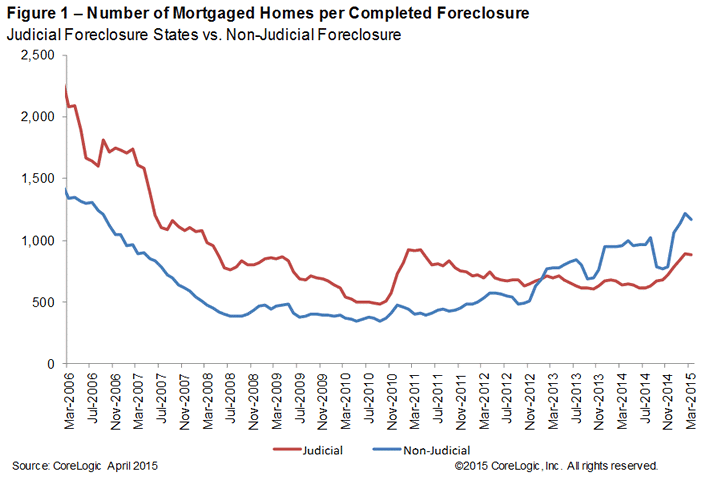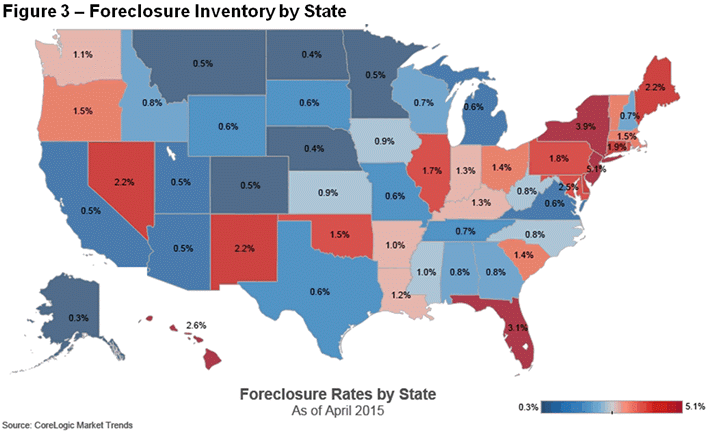It continues to be clear that the foreclosure crisis is winding down while ongoing elevated levels of mortgage distress mean it could be a long time before it actually ends. CoreLogic's April 2015 National Foreclosure Report shows dramatic year-over-year declines in both delinquencies and completed foreclosures and a foreclosure inventory that has shrunk to less than a third of its peak level. It also shows these statistics remain at levels far above historic "norms."
The company said that there were 40,000 completed foreclosures nationwide in April compared to 50,000 in April 2014, a decline of 19.8 percent year-over-year and down 65.8 percent from the foreclosure peak in September 2010.
The rate of completed foreclosures in April was nearly identical to the previous month. Both were reported at 40,000 although CoreLogic said there was a month-over-month decline of 1.1 percent. As a basis of comparison completed foreclosures averaged 21,000 per month nationwide between 2000 and 2006.

Since the financial crisis began in September 2008, there have been approximately 5.7 million homes lost to foreclosure nationwide and since homeownership rates peaked in the second quarter of 2004 there have been approximately 7.8 million foreclosures.
The five states with the highest number of completed foreclosures for the 12 months ending in April 2015 were: Florida (106,000), Michigan (49,000), Texas (33,000), Ohio (28,000) and Georgia (27,000). These five states accounted for almost half of all completed foreclosures nationally.
As of April 2015, the national foreclosure inventory, that is homes in the process of foreclosure, stood at approximately 521,000, or 1.4 percent, of all homes with a mortgage. In April 2014 there were 694,000 homes in the inventory, a rate of 1.8 percent. The April inventory was down by 2.2 percent from March 2015 and at a rate of 1.4 percent is back to early 2008 levels.
Four states and the District of Columbia had the highest foreclosure inventory as a percentage of all mortgaged homes: New Jersey (5.1 percent), New York (3.8 percent), Florida (3.1 percent), Hawaii (2.6 percent) and the District of Columbia (2.5 percent). The District of Columbia was also counted among the five locations with the lowest number of completed foreclosures. Black Knight Financial Services reported yesterday that, at the current rate, it could take 43 years to clear the District's backlog of distressed mortgages.

CoreLogic also reports that the number of mortgages in serious delinquency (defined as 90 days or more past due, including those loans in foreclosure or REO) declined by 22.1 percent from April 2014 to April 2015, with 1.4 million mortgages, or 3.6 percent of the total, falling into this category. This is the lowest serious delinquency rate since February 2008. On a month-over-month basis, the number of seriously delinquent mortgages declined by 3 percent.
"By mid-2011, after the Great Recession and at the trough of the house-price collapse, more than 1.5 million homes were in the foreclosure pipeline," said Frank Nothaft, chief economist for CoreLogic. "Employment recovery, foreclosure alternatives, and home-value gains have worked to reduce this inventory. At CoreLogic, we found that April's foreclosure inventory was down 25 percent from a year ago, falling to one-third the mid-2011 level."
"Despite a slow and steady improvement in most housing market fundamentals, too many families remain in default of their mortgage obligations," said Anand Nallathambi, president and CEO of CoreLogic. "The percent of homeowners with a mortgage that have missed three-or-more monthly payments or are in foreclosure proceedings dropped to 3.6 percent in our April data; while well below the record peak of nearly 9 percent and the lowest in more than seven years, it remains about double the pre-2007 rate."







